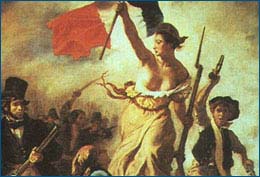Basics
Sound can enrich the sensory experience of art and aid in conveying concepts to individuals who are blind or visually impaired. By incorporating movement and sound, creative drama maximizes an audience member’s kinesthetic impressions, sensory experience, and emotional response.
Approaches Using Sound and Drama
How to Use This Tool
Getting Started
Try It Yourself
Approaches Using Sound and Drama
Sound Images or Interpretive Sound Compositions
Created by professional musicians, interpretive sound compositions are combinations of sound and narration that aim to create aural equivalents of a particular artwork or artistic style. They help to evoke the experience of a a work of art and help listeners have a “gut” reaction, as if they were standing in front of the work.
Music of the Period
Period music in galleries and classrooms can evoke specific ages and regions. For example, Renaissance or Baroque music, African drums or medieval church bells will provide a sensory understanding of a work of art and its context.
Using Musical Instruments to Convey Motion, Rhythm, and Action
Children can be encouraged to experiment with simple and hand-made musical instruments to connect sound with different rhythmic motions.
How to Use This Tool
In Museums
Sound and drama enhance touch tours. Educators can also recommend sound compositions and creative drama to tour groups as part of a pre- or post-museum activity.
In Classrooms
Teachers can use sound compositions, period music, musical instruments, and creative drama to prepare students for a museum visit, or to augment a lesson on history, social sciences, literature, or the arts.
As Individuals
Sound images accompany ABS’s series Art History Through Touch and Sound, which is designed to be easily used by individuals. With a little research, individuals can also gain insights into an artwork’s content through music of the period.
Getting Started
Listen to Examples of Sound Images
Sound images for Surrealism, Abstraction, and Cubism can be found on the tapes with the volume European Modernism: 1900–1940 of Art History Through Touch and Sound, as well as on ABS’s Web site. These sound interpretive compositions are created to convey the artistic properties of a style such as Surrealism, rather than a painting, so they lend themselves for use in galleries and classrooms.
Research Music and Musical Instruments of the Period
You can research music that was played in a particular time, or on the musical instruments of the period or region.
- Create simple musical instruments with young children as a group project for preschool children and elementary school students.
- Introduce the children to musical instruments such as bells, a rhythm box, rain stick, or rattle and let the students experiment with them.
- Ask students to make their own instruments, for example, a sealed cup with rice, beans, or bells inside, then to decorate their instruments and play them. Record the sounds of their instruments and play them back to the group.
- Remember: Music and drama will not be appropriate for every work of art, nor will you find music, sound compositions, or movement that will match every artwork. Also, performance arts such as drama and music are enjoyed, studied, and professionally performed by people who are blind and visually impaired.

